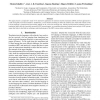Free Online Productivity Tools
i2Speak
i2Symbol
i2OCR
iTex2Img
iWeb2Print
iWeb2Shot
i2Type
iPdf2Split
iPdf2Merge
i2Bopomofo
i2Arabic
i2Style
i2Image
i2PDF
iLatex2Rtf
Sci2ools
LREC
2010
2010
Towards Improving English-Latvian Translation: A System Comparison and a New Rescoring Feature
This paper presents a comparative study of two alternative approaches to statistical machine translation (SMT) and their application to a task of English-to-Latvian translation. Furthermore, a novel feature intending to reflect the relatively free word order scheme of the Latvian language is proposed and successfully applied on the n-best list rescoring step. Moving beyond classical automatic scores of translation quality that are classically presented in MT research papers, we contribute presenting a manual error analysis of MT systems output that helps to shed light on advantages and disadvantages of the SMT systems under consideration.
| Added | 29 Oct 2010 |
| Updated | 29 Oct 2010 |
| Type | Conference |
| Year | 2010 |
| Where | LREC |
| Authors | Maxim Khalilov, José A. R. Fonollosa, Inguna Skadina, Edgars Bralitis, Lauma Pretkalnina |
Comments (0)

